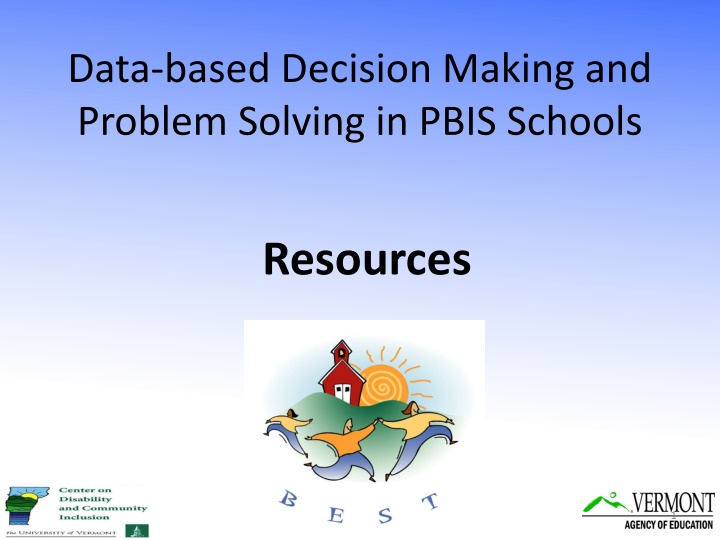
Effective Problem-Solving Strategies in PBIS Schools
This resource provides a comprehensive guide on data-based decision-making and problem-solving in Positive Behavioral Interventions and Supports (PBIS) schools. It includes questions to ask when identifying and defining problems, along with practical steps for implementing solutions and evaluating their effectiveness. The content emphasizes the importance of precise problem statements, understanding the nature of problems, and outlining detailed action plans. It also delves into why problems occur and offers strategies for prevention, teaching, rewarding positive behaviors, extinction of unwanted behaviors, corrective consequences, and data collection to measure progress.
Download Presentation

Please find below an Image/Link to download the presentation.
The content on the website is provided AS IS for your information and personal use only. It may not be sold, licensed, or shared on other websites without obtaining consent from the author. If you encounter any issues during the download, it is possible that the publisher has removed the file from their server.
You are allowed to download the files provided on this website for personal or commercial use, subject to the condition that they are used lawfully. All files are the property of their respective owners.
The content on the website is provided AS IS for your information and personal use only. It may not be sold, licensed, or shared on other websites without obtaining consent from the author.
E N D
Presentation Transcript
Data-based Decision Making and Problem Solving in PBIS Schools Resources 1
Questions to Ask.. (TIPS Problem-Solving Mantra ) Innovation neutral: Use for Reading, Behavior, Math, School Improvement 1. Do we have a problem? (identify) 2. What is the precise nature of our problem? (define, clarify, confirm/disconfirm inferences) 3. Why does the problem exist, & what can we do about it? (hypothesis & solution) 4. What are the actual elements of our plan? (Action Plan) 5. Is our plan being implemented, & is it working? (evaluate & revise plan) 2
Who? 3
What? 4
Where? 5
When? 6
Our Precise Problem Statement. Students in ______ grade are _______________ (Grade/s) (Problem Behavior/s) in the ________________between (Location/s) ________and _________. (Start Time) (End Time) We need to take it one step further Why is this happening? 7
Why? 8
What is the precise nature of our problem (define, clarify, confirm/disconfirm inferences)? Question: What problem behaviors are occurring? When are problem behaviors occurring? Where are problem behaviors occurring? Who is engaging in problem behaviors? Why do problem behaviors keep happening? Fill in the information below: 9
What are the actual elements of our plan? Precise Problem Statement: Prevention: Remove/alter trigger for problem behavior Teaching: Define, instruct & model expected behavior Reward: Expected/alternative behavior when it occurs; prompt as necessary Extinction: Increase acknowledgement of presence of desired behavior Corrective Consequence: Use non- rewarding/non-reinforcing responses when problem behavior occurs Data Collection: Indicate how you know when you have a solution 10
What are the actual elements of our plan? Precise Problem Statement: The sixth graders are disruptive & use inappropriate language in the cafeteria between 11:30 AM and 12:00 PM to get peer attention. Maintain current lunch schedule, but shift classes to balance numbers. Prevention: Remove/alter trigger for problem behavior Teach behavioral expectations in cafeteria Teaching: Define, instruct & model expected behavior Establish Friday Five : Extra 5 min of lunch on Friday for five good days. Reward: Expected/alternative behavior when it occurs; prompt as necessary Encourage all students to work for Friday Five make problem behavior less rewarding than desired behavior Extinction: Increase acknowledgement of presence of desired behavior Active supervision and continued early consequence (ODR) Corrective Consequence: Use non- rewarding/non-reinforcing responses when problem behavior occurs Maintain ODR record and supervisor weekly report Data Collection: Indicate how you know when you have a solution 11
